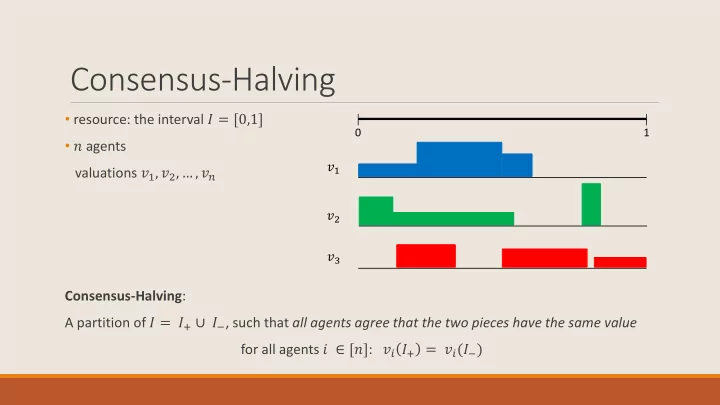

Consensus-Halving • resource: the interval 𝐽 = [0,1] 0 1 • 𝑜 agents 𝑤 1 valuations 𝑤 1 , 𝑤 2 , … , 𝑤 𝑜 𝑤 2 𝑤 3 Consensus-Halving : A partition of 𝐽 = 𝐽 + ∪ 𝐽 − , such that all agents agree that the two pieces have the same value for all agents 𝑗 ∈ [𝑜] : 𝑤 𝑗 𝐽 + = 𝑤 𝑗 (𝐽 − )
The Consensus-Halving Problem Theorem [Hobby-Rice 1965, Simmons-Su 2003]: There always exists a Consensus-Halving using at most 𝑜 cuts. Computational Problem : “Compute a Consensus -Halving that uses at most 𝑜 cuts” Theorem [Filos-Ratsikas, Goldberg 2018-19]: Consensus-Halving is PPA-complete for piecewise-constant valuations. Theorem : Consensus-Halving is PPA-complete, even for 2-block uniform valuations . 𝑤 1 𝑤 2 𝑤 3
The TFNP landscape Pigeonhole Principle Parity Argument • TFNP Borsuk-Ulam • Consensus-Halving PPA PLS PPP PPAD P Directed Parity Argument Potential Argument/Local Search • Brouwer • Local Max-Cut • Nash
Single-block valuations: Positive Results Theorem : ε -Consensus-Halving for single-block valuations can be solved in poly-time in the following cases: 1 • ε = 2 → technique: greedy algorithm • 2𝑜 − 𝑙 cuts allowed, for any constant 𝑙 → technique: polynomial number of LPs 𝑤 1 • the maximum overlap number 𝑒 is constant 𝑤 2 → technique: dynamic programming 𝑤 3
Recommend
More recommend